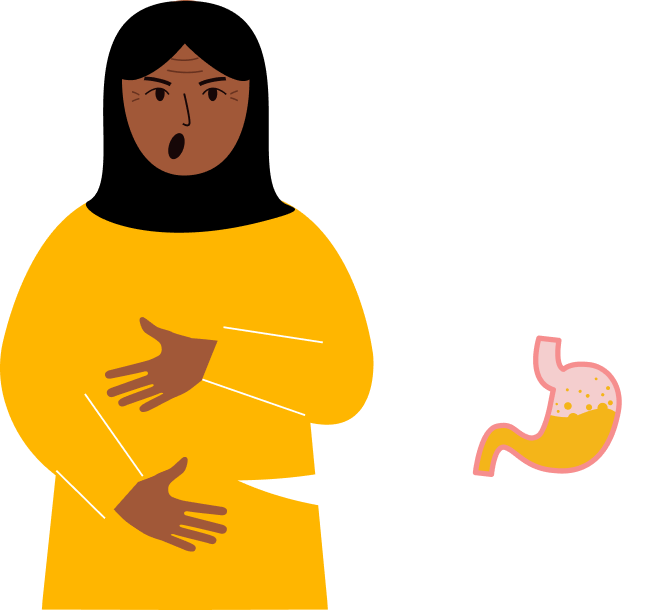You may also like…
Common Infections during Pregnancy
Chicken pox in pregnancy (Varicella Zoster Virus)
Transmitted through: Varicella Zoster Virus (VSV), through droplet spread and direct physical contact.
Prevalence in Pakistan: Chickenpox is caused by the VZV and has been reported to have a prevalence of 41.8% in Pakistan.
Clinical features: non immune pregnant woman are more vulnerable to developing serious pneumonia, hepatitis, encephalitis. The mortality rate is 5 times higher in pregnant woman compared to non-pregnant women. At a later time in pregnancy such as the third trimester; pneumonia becomes very severe from chickenpox.
Management:
First things first:
- Avoid exposure during pregnancy
- You should immediately let your doctor know if you come into contact with anyone going through chickenpox
- Significant exposure means spending 15 minutes in a room with someone who is contagious, or having face to face contact.
- Contagious means that the person is infectious and this means 2 days before the first rash and 5 days till the last vesicles crust over.
- Women who get chickenpox should avoid other woman till their lesions have crusted over and fallen off and they are now at a non-infectious/contagious stage in their disease progression.
Treatment
- Oral Acyclovir 800 mg/ 5 times a day should be for 7 days should be prescribed for pregnant woman should be given if they show up within 24 hours of the rash to the doctor and if their pregnancy is now 20 weeks+. Acyclovir should also be considered prior to 20 weeks of pregnancy.
Delivery during infectious stage
A delivery during infectious stage may become problematic with the mother suffering from issues such as bleeding, thrombocytopenia (low platelet count in blood, bleeding risk) , disseminated intravascular coagulopathy (rare and serious disorder where abnormal blood clotting occurs throughout all of body's blood vessels) and hepatitis (inflammation of the liver). In addition, there is a very high probability that the baby will get infected too and there are decreasing chances of the baby surviving this delivery.
In order to avoid these complications, supportive treatment and intravenous drips of acyclovir are preferred, allowing the rash to disappear and and helping transfer of antibodies from mother to fetus. However, delivery is needed in women if the varicella pneumonia poses serious threat to respiratory system failure.
Testing for chickenpox: test of "VZV IgG" done within 24-48 hours and done from serum of a blood sample.
How to be more careful?
If you have had contact with someone who has recently had chickenpox and you are non-immune then you need to get a varicella zoster Immunoglobulin(VZIG) within 10 days of contact, and regardless of this you must notify the doctor that you are booked with. It must be stressed that this immunoglobulin has no effect once chickenpox has developed.
When should you go for an abortion?
Fetal Varicella syndrome comprises of skin scarring, eye defects, hypoplasia of the limbs (smaller arms and legs), and neurological abnormalities. This happens in only 1% of infected fetuses. If the mother has contacted the disease during pregnancy, at 16-20 weeks or 5 weeks after this contact and ultrasound should be done to evaluate if the fetus has any deformities that might make life compatibility difficult.
Rubella/German measles in pregnancy
Transmitted through: Rubella is spread by droplet transmission
Prevalence in Pakistan A study conducted on pregnant woman showed a positive rubella test in 83.4% of women.
Clinical features:
- Mild flu-like symptoms similar to those of a common cold (low-grade fever, headache, runny or stuffy nose, and general malaise)
- Rash: A distinctive rash is a hallmark of rubella (beginning on the face and then spreading to rest of body, this rash is pink or consists of pink or light red spots that merge together, giving a blotchy appearance). This rash usually lasts about three days and maybe itchy for some individuals.
- Lymphadenopathy: swollen and tender lymph nodes
- Arthralgia (joint pain)
Why is time of pregnancy important when we talk about mother being infected with rubella?
After 20 weeks of pregnancy, Rubella does not carry any risk to the fetus, however, before 11 weeks of pregnancy the mothers who contacted the virus have babies that are all infected with rubella- this estimate is 100%. At the end of the second trimester this percentage of babies born who have congenital defects falls to 25%.
What if infection during pregnancy is confirmed?
Depending on when the pregnant woman got her infection during her pregnancy timeline, the risk of getting Congenital Rubella Syndrome for her baby should be assessed. If this happened before 16 weeks of pregnancy, termination of pregnancy can be discussed, if this happened after the 16 weeks’ deadline, then risks should be discussed and reassurance should be given.
Management
First things first
- Rubella is a highly contagious viral infection so its crucial to prevent exposure to the virus during pregnancy. Pregnant women who are not immune to rubella should avoid close contact with individuals who have rubella, rash, or illness.
- Immune globulin administration: if a pregnant woman who is not immune to rubella is exposed to the virus, the administration of rubella immune globulin (RIG) may be considered. However, the effectiveness of RIG is highest when given within 72 hours of exposure.
Treatment
- Supportive care: There is no specific antiviral treatment for rubella, so management primarily focuses on supportive care. Pregnant women are advised plenty of rest, advised to stay hydrated, and take-over-the counter medications (acetoaminophen), to relieve fever, and discomfort (under the guidance of a healthcare provider)
Testing for rubella: Rubella infection is typically diagnosed based on clinical symptoms, history of exposure, and laboratory tests. If a pregnant woman suspects she has Rubella or has been exposed to the virus, she should seek medical attention promptly for diagnosis.
When should you go for an abortion?
The decision to pursue an abortion in the case of rubella infection during pregnancy is a complex and personal one. If a pregnant woman contacts Rubella, especially during the first trimester, there is an increased risk of CRS (Congenital Rubella Syndrome). CRS may lead to multiple birth defects, including hearing loss, heart abnormalities, developmental delays and intellectual disabilities, and vision problems. It is crucial for a pregnant woman to approach medical guidance (obstetricians and gynecologists) to seek individualized care and special guidance.
Syphilis in pregnancy
Transmitted through: Syphilis is a sexually acquired infection caused by treponema pallidum.
Prevalence in Pakistan According to a study done in Pakistan on 1532 participants- people with active syphilis were 452, estimate of 29.5% (Ann Saudi Med, May-Jun 2011).
Clinical Features:
Primary syphilis may present as a painless ulcer 3-6 weeks after the body gets infected through some other source. Secondary syphilis presents itself in the time period of 6 weeks to 6 months and usually occurs as a rash that appears as a flat, red area on the skin covered in small confluent bumps. This is called a chancre (painless, firm, and round ulcer most often occurring around genitals, rectum or mouth. Subsequently about 20% affected develop cardiovascular related sequelae and about 5-10% develop neurological related sequelae.
In its secondary stage, its characterized by a rash that may appear as reddish-brown or copper-colored spots or small, raised lesions. The rash may involve various parts of the body, including palms of the hands and soles of the feet.
Babies of Syphilis-infected mothers:
Pregnant women with early, untreated syphilis, 70-100% infants are infected and 25% are stillborn (dead at birth). In addition, infected babies through mother-to-child transmission carry with them the consequences of fetal growth restriction, fetal hydrops, congenital syphilis (which may cause long term disability), stillbirth, preterm birth and neonatal death.
Screening: Pregnant women are routinely screened for syphilis early in pregnancy during their prenatal care visits. Screening typically involves a blood test to detect antibodies against the causing bacteria: Treponema pallidum. If a pregnant woman has a high risk of syphilis or resides in an area with a high prevalence of the infection, additional screening may be recommended during the third trimester at delivery.
How to manage this infection?
After you have been diagnosed, an appointment with the gynecologist should be setup in order to start the appropriate course of therapy. The parenteral penicillin has a 98% success rate for preventing congenital syphilis. Prompt treatment decreases transmission of disease to fetus. When syphilis is diagnosed, the pregnant lady should be frequently evaluated for for infection and to asses fetal growth and development.
Neonatal Management:
If a pregnant woman with syphilis delivers before completing treatment, the newborn should receive appropriate evaluation and treatment. This may involve a physical examination, blood tests, and a lumbar puncture to assess the baby's condition and the presence of syphilis infection. Treatment with antibiotics is typically recommended for newborns diagnosed with syphilis.
What if you decide to not get treated for this infection once you have encountered it?
If a woman is not treated during her pregnancy then her baby should be treated after delivery, an infected baby may be born without symptoms of disease but if its not prompt treatment should always be given as it will develop serious problems within a few weeks. These may include developmental delay, seizures and sometimes death.
Cytomegalovirus in pregnancy
Transmitted through: Cytomegalovirus is spread through direct contact with infectious body fluids, such as urine, saliva, blood, tears, semen and breast milk.
Prevalence in Pakistan: reported to be more than 90%, when measured using HCMV specific IgG antibody.
Clinical features: primary infection causes no abnormalities but on the ultrasound scan main signs affecting the fetus are growth restriction, microcephaly (abnormal head development), ascites or hydrops. Even when no abnormalities are seen, some infants are later found to be blind or deaf or have some form of developmental delay. The neonate can also be anaemic, thrombocytopaenic, with hepatosplenomegaly, jaundice and a purpural rash.
Testing for Cytomegalovirus: may be done through blood tests, a cerebrospinal fluid test (done through a spinal tap or lumbar puncture). Serological diagnosis includes developing CMV antibodies that were not present before the infection. It can be difficult to do this if there is a suspicion that the fetus may be infected, amniotic fluid can be tested for the virus by the PCR. The virus is lost in the fetal urine and therefore can be found in the amniotic fluid.
Management:
First things first
Preventive measures are far better than curative measures. This includes practicing good hygiene, such as frequent handwashing with soap and water, avoiding close contact with young children's saliva or urine, and practicing safe sexual behaviours.
Treatment
Supportive care can be given to the infected pregnant woman because there is no specific treatment for congenital CMV infection. In cases where the fetus is diagnosed with severe complications, special and individualized medical care is given and this varies from person to person. The fetus is very closely monitored through regular ultrasounds to assess fetal growth and development.
Herpes in pregnancy
Herpes Simplex Virus is of two types HSV 1 and HSV 2. The major chunk of infections caused by herpes present as orolabial infections caused by HSV, most acquired through childhood from physical contact such as kissing. Genital herpes, is caused by HSV 2 and is a sexually transmitted infection.
Prevalence of Herpes in Pakistan: The prevalence of HSV-2 in Pakistan is around 3.4%.
Clinical features: presents as ulcerative lesions on vulva, vagina or cervix. Some women may give a history of this being a recurrent problem. Neonatal herpes can be caused by both types of the virus, mostly occurring as a direct contact with maternal secretions and some cases occurring through postnatal transmission. Neonatal herpes occurs in 3 types: (1) disease localized to skin, eye and mouth (2) local central nervous system (3) infection within the bloodstream.
Testing: A vaginal swab for viral detection should be used, anyone with a first-episode detected infection should be referred to a gynecologist for further evaluation which will include a PCR or viral culture (for 100 percent confirmation of presence of disease), and further management and a screening for sexually transmitted infections.
Treatment: Using acyclovir 400 mg thrice daily reduces duration and severity of viral shedding and in safe and well tolerated in pregnancy.
Group B Streptococcus in pregnancy
Group B Streptococcus is a gram positive coccus (type of bacteria) naturally present as the microbiota of the vaginal flora. It is the most frequent cause of neonatal sepsis (an infection involving bloodstream in newborn infants less than 28 days old) in neonates.
Risk Factors include Intrapartum fever (>38 degrees Celsius), prolonged rupture of membranes >1 hours, prematurity <37 weeks, previous baby with GBS (Group B Streptococcus), incidental detection of GBS in current pregnancy, GBS (bacteriuria-bacteria in urine) or urinary infection.
Clinical features include sudden collapse, tachypnea, nasal flaring, poor tone and jaundice etc while in the mother it shows no symptoms.
Management:
To prevent neonatal GBS infection, pregnant women are often screened for this and colonization in the vagina and rectum between weeks 35 weeks and 37 weeks of gestation. If a woman tests positive for GBS or has the risk factors that have been discussed previously, she will be offered intravenous antibiotics during labor to reduce the risk of transmitting the bacteria to the baby.
Includes detecting an incidental finding. However, treatment is not initiated as this does not reduce the chances of baby getting infection during delivery. Antibiotics given during labor instead are 60-80 percent effective in decreasing the likelihood of getting early-onset neonatal GBS. The Royal College of Obstetricians and Gynecologists recommend treatment of antibiotic prophylaxis for women who have more than one risk factory.






